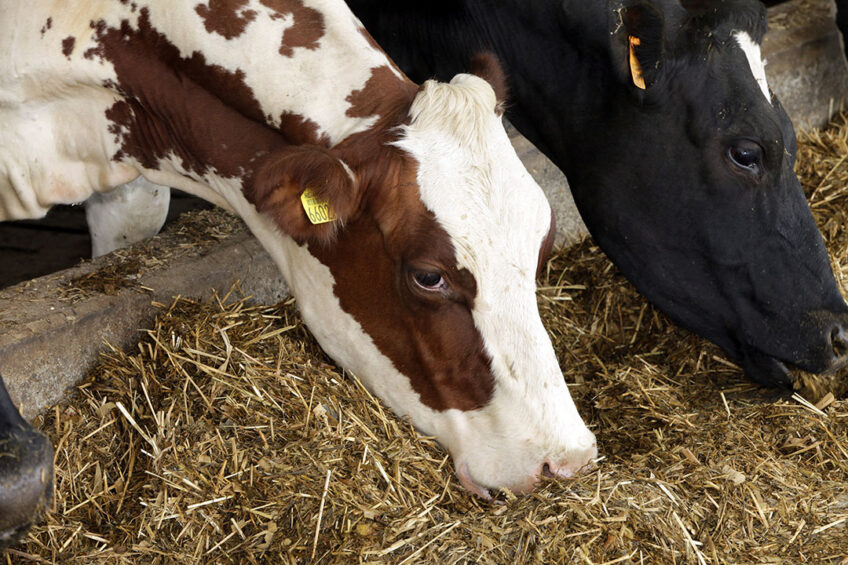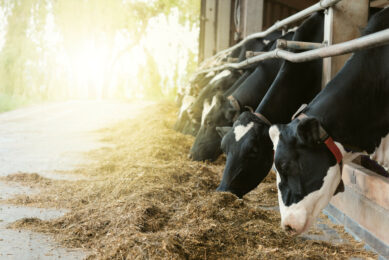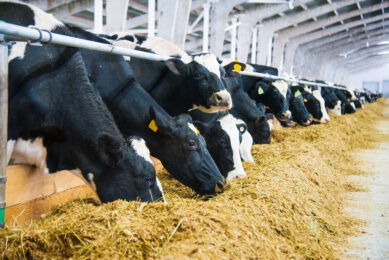Dietary manipulation for less methane output

Not only from an environmental standpoint, but also to improve rumen function and performance of the cow, it is important to mitigate methane production.
Methane, a product of rumen fermentation which is eructated by the ruminant, can result in a loss equivalent to 8-10% of the energy intake of the animal which could otherwise be utilised for productive purposes. The following is a review of the feeding strategies that can be adopted to achieve these targets, along with the points to consider when choosing a given strategy.

Hay-to-concentrate ratio
A study was conducted to examine the effect of hay-to-concentrate ratios at the same crude protein content (12%) of diet on methane production in goats. The 5 levels of hay-to-concentrate ratios were 90 to 10 (H90), 75 to 25 (H75), 60 to 40 (H60). 45 to 55 (H45), and 30 to 70 (H30), which approximately met maintenance energy requirements. Methane production per unit DM intake increased with a rise in the ratio of concentrate intake to hay intake until H45. However, the ratios of methane energy loss to ME intake were similar. These results imply that if ME intake of goats is at a maintenance energy level, daily methane production is not influenced by the hay-to-concentrate ratio. In another study, lactating cows were fed 1 of the 3 levels of roughage to concentrate ratios: 70 to 30 (R70), 50 to 50 (R50), or 30 to 70 (R30). High concentrate diet reduced both methane production per unit DM intake and the ratio of methane energy loss to ME intake compared with low concentrate diet. Therefore, in lactating cows, it is important to increase the ratio of concentrate to total diet in order to reduce daily methane production
CP content of diets
Shown in Table 1 is the effect of crude protein (CP) content on methane production in goats fed a maintenance energy level diet.
The 4 levels of CP content were:
- 4% (CP4).
- 7% (CP7).
- 9% (CP9),
- 12% (CP12).
Methane production per unit DM intake and the ratio of methane energy loss to ME intake increased with the rise in CP content of diets from CP4 to CP9. However, the difference between CP9 diet and CP12 diet was not clear. These tendencies also agreed with the results in dry cows. However, when animals were fed sufficient CP above the maintenance energy level, daily methane production was negatively related to daily CP intake
Fat supplement
The addition of fat to the ruminant rations appears to be an efficient and easy way of reducing methane production and hence alleviating the negative effects of methane on energy efficiency, rumen fermentation, and animal performance. The effect of fats on methane production may, however, vary depending on the fat source (Table 2), and may be attributed to the bio-hydrogenation of unsaturated fatty acids in the rumen, promotion of propionic acid production, and prevention of protozoa activity.
Potential role of the seaweeds
Seaweeds such as Ulva sp., Gigartina sp., and G. vermiculophylla are used at the Atlantic and Mediterranean coasts as feed sources for livestock during periods of feed scarcity. This is due to their richness in organic minerals, complex carbohydrates, proteins, lipids, vitamins, volatile compounds, pigments, and bioactive substances with broad biological activities. Additionally, they effectively reduce rumen methane production without any detrimental effect on the other rumen fermentation parameters (Table 3). The effect of seaweeds may, however, vary depending on the substrate used. That is, the first 2 species (Ulva sp. and Gigartina sp.) are more effective in reducing methane production when used with grass hay at 25%, while the third (G. vermiculophylla) is effective only when used with corn silage at the same rate.
Herbs and herbal extract
Herbs and herbal extracts such as neem (Azadirachta indica), garlic (Allium sativum), ginger (Zingiber officinale), kadukka (Terminalia chebula) and Amla (Emblica officinalis) contain secondary metabolites such as lignin, tannins, terpenoids, volatile essential oils, alkaloids, etc. They have anti-microbial activity and inhibit rumen microbial growth in a very specific way and hence can be used for selective amelioration of rumen fermentation especially methanogenesis. Moreover, herbs or their extracts are unlikely to produce any residual effects in the animal products as they are organic and have been used for centuries by the human race without adverse effects.
Exogenous enzymes
Enzymes, such as cellulase and hemicellulase, are currently used in ruminant diets. When properly formulated, enzymes can improve fibre digestibility and animal productivity. Enzymes that improve fibre digestibility typically lower the acetate-to-propionate ratio in the rumen, ultimately reducing methane production.
Microbial feed additives and probiotics
The use of acetogenic bacteria as microbial feed additives along with some anti-methanogenic compound may be effective in methane inhibition. Probiotics such as yeast cultures are used to stimulate bacterial activity in the rumen. The probiotics have been shown to stabilise rumen pH, increase propionate levels and decrease the amount of acetate, methane, and ammonia production.
Ionophores
Ionophores such as monensin and lasalocid, are generally used as feed additives in order to improve the efficiency of digestion in ruminants. These ionophore antibiotics are carboxylic polyether compounds produced by various strains of Streptomyces, e.g. Monensin by S. cinnamonensis and lasalocid by S. lasoliensis. Monensin is moderately active against gram-positive bacteria, certain mycobacteria, and coccidian, while lasalocid is specifically active against hydrogen-producing bacteria and results in higher propionate production which in turn is related to low methane production.
Conclusions
Several nutritional strategies have been studied and developed to mitigate enteric methane. The choice of which one to adopt should be based on its capacity to reduce methane emissions associated with the economic viability and animal performance.
- An increasing proportion of the hay to concentrate ratio will mitigate methane production and hence improve livestock productivity but at the same time is too costly for ruminant feed. Proper chopping of the roughage material may provide an alternative solution when the supply of concentrate is limited.
- Another thing that needs to be considered in selecting the appropriate method to reduce methane emissions, is its effect on the livestock as an entire system rather than only the rumen fermentation. For example, it is unwise to reduce methane production by reducing the supply of protein, the case in which there will be negative effects on livestock productivity and health.
- Fat supplement is an interesting option but animals will reject the diet if it is too high in fat due to its inconvenient smell.
- Seaweeds have a great potential in reducing methane production, but the substrate to be used with them should be considered. Some of these weeds can be effective when used with silage, while others are effective only when used with hay.
- Enzymes and microbial additives are effective means of mitigating methane production in the rumen.
- Ionophore antibiotics are also effective in reducing methane but the banning of such products is important to consider.
References are available from the author upon request.
Join 13,000+ subscribers
Subscribe to our newsletter to stay updated about all the need-to-know content in the dairy sector, two times a week.










